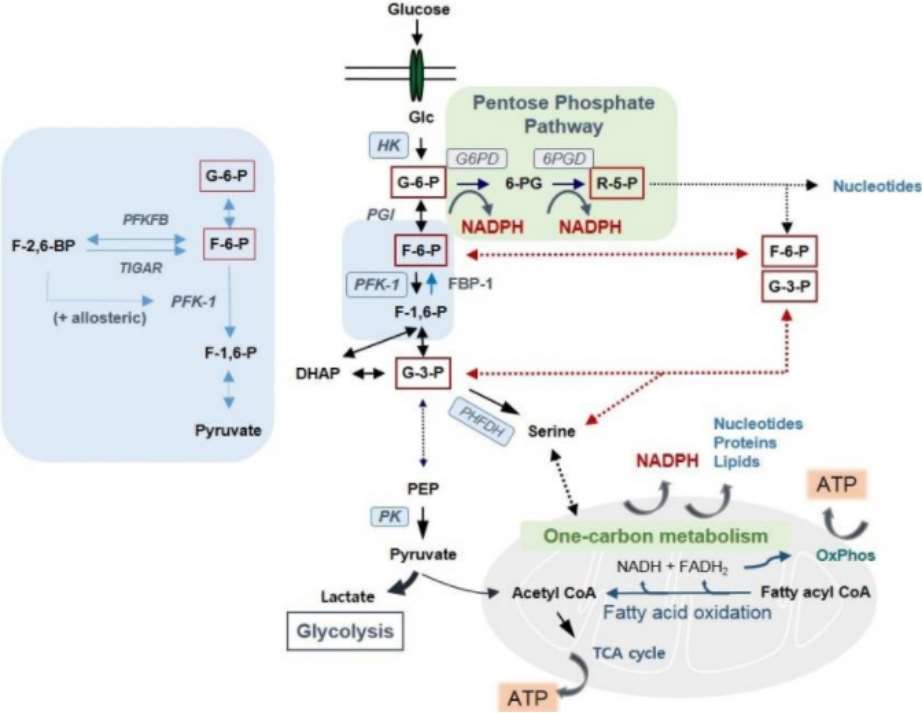Intracellular metabolic rates (fluxes) provide critical insights into the metabolic state of an organ or cell. 13C-Metabolic flux analysis (MFA) based on mass spectrometry (MS) is a powerful tool to analyze the flow of carbon through metabolic networks. MFA can help researchers gain insight into the various complex metabolic processes within cells, visually revealing the major intracellular activity pathways, the relative contribution of each pathway, and the characteristics of their distribution changes. Based on advanced instrument platforms and experienced experts, we are able to provide MS-based metabolic flux analysis to study fluxes in bacteria, fungi, mammalian cells, or intact tissues.
Pentose phosphate pathway (PPP)
The pentose phosphate pathway (PPP) is a mode of oxidative glucose catabolism that is prevalent in animals, plants and microorganisms. In addition to providing energy, PPP in organisms is primarily responsible for providing a variety of raw materials for anabolism. For example, PPP provides reduced nicotinamide adenine dinucleotide phosphate (NADPH) for fatty acid and cholesterol biosynthesis; ribose 5-phosphate for nucleotide coenzyme and nucleotide synthesis; and erythrose 4-phosphate for aromatic amino acid synthesis.
 Fig. 1 The glycolysis and PPP are tightly connected. (Cho, Eunae Sandra, et al, 2018)
Fig. 1 The glycolysis and PPP are tightly connected. (Cho, Eunae Sandra, et al, 2018)
PPP metabolic flux analysis service at Creative Proteomics
MS has the characteristics of versatility, high throughput, and sensitivity, and can simultaneously determine a large number of metabolites with low in vivo concentration, high polarity, and complex matrix. Moreover, MS provides sufficient resolution to discriminate and quantify stable-isotope labeled (e.g., 13C, 2H, 15N) and unlabelled low molecular weight metabolites. At Creative Proteomics, we provide solutions for MFA of a range of mature cellular and tissue samples mainly based on GC-MS and LC-MS highly complementary detection platforms. Our service can quantitatively characterize the entire metabolic process and its precise flux distribution, identify rigid nodes of metabolic pathways, and greatly facilitating PPP and related research.
We can help researchers track changes in the following intermediate metabolites of PPP, but are not limited to:
- Glucose-6-phosphate
- 6-Phosphoric acid-gluconolactone
- Ribulose-5-phosphate
Sample requirements
Cells, tissues, and microbial organisms
Cell number: 1×107 cells/sample
Biological replicates: 6-10 biological replicates
Detection platform
- GC-MS, LC-MS and NMR highly complementary detection platforms
- 13C-labeled Glucose carbon flux analysis
- 13C-labeled Glutamine carbon flux analysis
- 15N-labeled Glutamine nitrogen metabolic flux analysis
General project cycle
- Experimental testing: 50 natural days
- Data analysis: 7 natural days
Why choose us?
- 13C and 15N multi-marker tracers covering 100+ species of multi-pathway labeled metabolites
- Practical ultra-complete adherent cell and suspension cell metabolic flow collection scheme
- Packaged/customized metabolic flux assay and result interpretation integration service
- Experienced in large scale projects
If you have are interested in our PPP metabolic flux analysis service, please don't hesitate to contact us. We look forward to working on your next project.
Reference
- Cho, Eunae Sandra, et al. "The pentose phosphate pathway as a potential target for cancer therapy." Biomolecules & therapeutics 26.1 (2018): 29.